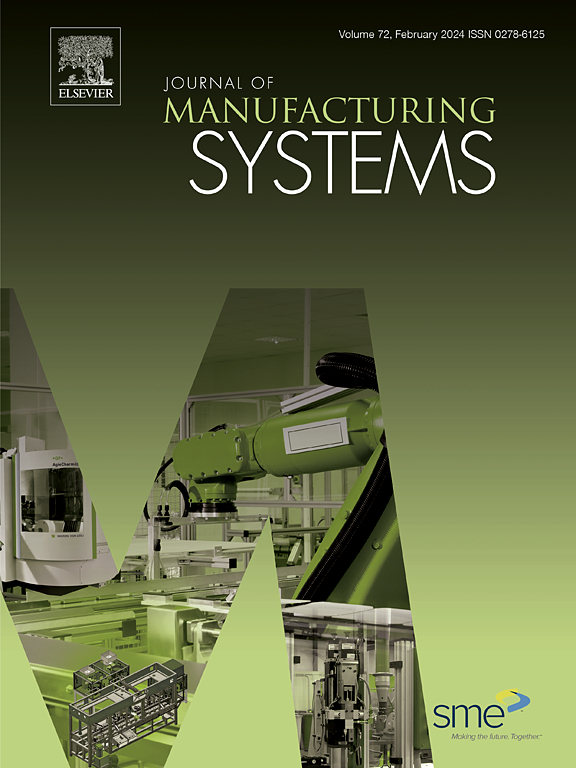Energy-efficient human-robot collaborative U-shaped disassembly line balancing problem considering turn on-off strategy: Uncertain modeling and solution method
IF 12.2
1区 工程技术
Q1 ENGINEERING, INDUSTRIAL
引用次数: 0
Abstract
The quantity of waste automobile is becoming very large. Waste automobile not only occupies resources, but also easily pollutes the environment. How to realize the efficient and green treatment of recycled automobile is a hot topic in the industrial circular economy today. The disassembly line is the most efficient way to address large-scale waste automobile. Therefore, this paper takes the disassembly experiment of recycled automobile engine as the information orientation to construct energy-efficient human-robot collaborative U-shaped disassembly line balancing (HRU-DLB) framework considering turn on-off strategy. An engine disassembly information modeling method is proposed to address the issue on the actual disassembly space limitation. Establish a based-normal cloud HRU-DLBP mathematical model including disassembly smoothness, disassembly energy consumption (DEC), disassembly cost, disassembly idle time and disassembly carbon emission (DCE). To further reduce the disassembly energy consumption and carbon emission, the well-accepted energy-saving measure, known as the turn on-off strategy, is also integrated. Subsequently, a hybrid multi-objective optimization algorithm called ALNS-NSGA II, which combines the NSGA-II algorithm and adaptive large-scale neighborhood search algorithm is developed to explore the optimal Pareto solution set. Finally, the novel behavioral decision model is proposed to select the optimal HRU-DLB scheme. The comparative analysis shows that the turn on-off strategy can reduce DEC by 26 % and DCE by 3.1 % in a cycle time, respectively. The computational results confirm the feasibility and effectiveness of the proposed ALNS-NSGA II in solving the HRU-DLBP. The comparative analysis and sensitivity analysis demonstrate that the proposed behavioral decision model has better ranking and classification effects.
考虑开关策略的节能人机协同u型拆解线平衡问题:不确定建模与求解方法
废旧汽车的数量正变得非常大。废旧汽车不仅占用资源,而且容易污染环境。如何实现回收汽车的高效、绿色处理,是当今工业循环经济研究的热点问题。采用拆解流水线是处理大规模废弃汽车的最有效途径。因此,本文以回收汽车发动机的拆卸实验为信息导向,构建考虑开关策略的节能人机协同u型拆解线平衡(HRU-DLB)框架。针对发动机实际拆卸空间受限的问题,提出了一种发动机拆卸信息建模方法。建立了包含拆卸平滑度、拆卸能耗(DEC)、拆卸成本、拆卸空闲时间和拆卸碳排放(DCE)的基于正态云HRU-DLBP数学模型。为了进一步降低拆卸能耗和碳排放,还集成了被广泛接受的节能措施,即开关策略。随后,将NSGA-II算法与自适应大规模邻域搜索算法相结合,提出了一种混合多目标优化算法ALNS-NSGA II,探索最优Pareto解集。最后,提出了一种新的行为决策模型来选择最优的HRU-DLB方案。对比分析表明,开关策略在一个周期内可分别使DEC降低26 %和DCE降低3.1 %。计算结果证实了该算法求解HRU-DLBP问题的可行性和有效性。对比分析和敏感性分析表明,所提出的行为决策模型具有较好的排序和分类效果。
本文章由计算机程序翻译,如有差异,请以英文原文为准。
求助全文
约1分钟内获得全文
求助全文
来源期刊

Journal of Manufacturing Systems
工程技术-工程:工业
CiteScore
23.30
自引率
13.20%
发文量
216
审稿时长
25 days
期刊介绍:
The Journal of Manufacturing Systems is dedicated to showcasing cutting-edge fundamental and applied research in manufacturing at the systems level. Encompassing products, equipment, people, information, control, and support functions, manufacturing systems play a pivotal role in the economical and competitive development, production, delivery, and total lifecycle of products, meeting market and societal needs.
With a commitment to publishing archival scholarly literature, the journal strives to advance the state of the art in manufacturing systems and foster innovation in crafting efficient, robust, and sustainable manufacturing systems. The focus extends from equipment-level considerations to the broader scope of the extended enterprise. The Journal welcomes research addressing challenges across various scales, including nano, micro, and macro-scale manufacturing, and spanning diverse sectors such as aerospace, automotive, energy, and medical device manufacturing.
 求助内容:
求助内容: 应助结果提醒方式:
应助结果提醒方式:


